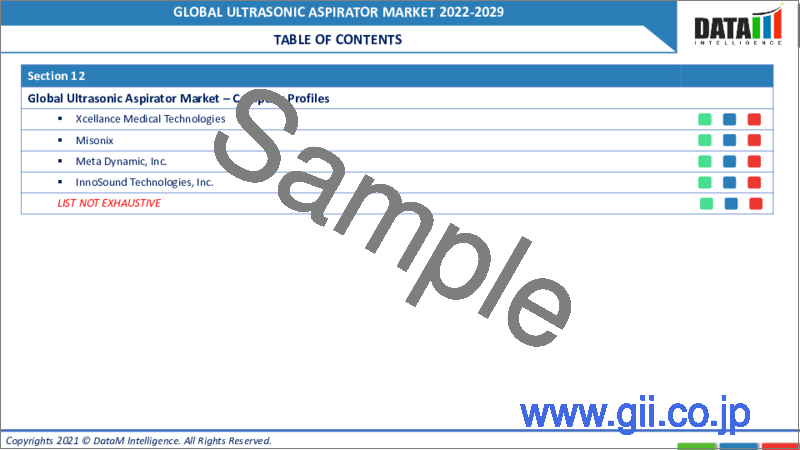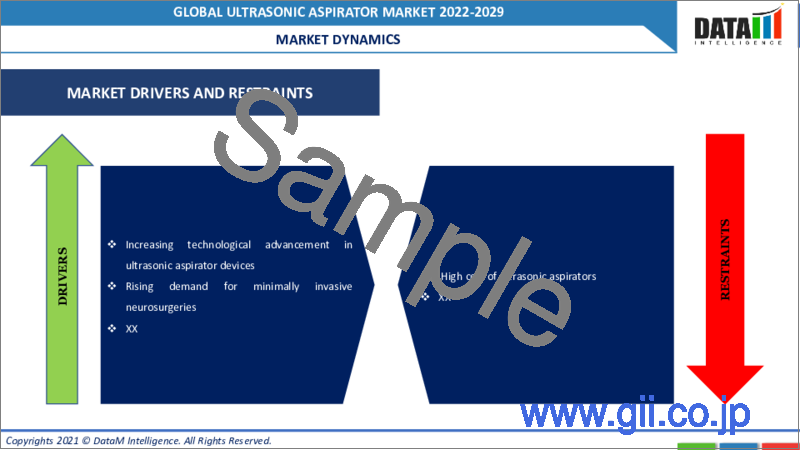|
|
市場調査レポート
商品コード
1146453
超音波吸引器の世界市場-2022-2029Global Ultrasonic Aspirator Market - 2022-2029 |
||||||
|
● お客様のご希望に応じて、既存データの加工や未掲載情報(例:国別セグメント)の追加などの対応が可能です。 詳細はお問い合わせください。 |
|||||||
| 超音波吸引器の世界市場-2022-2029 |
|
出版日: 2022年10月31日
発行: DataM Intelligence
ページ情報: 英文 200 Pages
納期: 約2営業日
|
- 全表示
- 概要
- 目次
市場の概要
超音波吸引器の世界市場規模は、予測期間(2022-2029年)にCAGR6.2%で成長するとされています。
超音波吸引器は、神経、血管、コラーゲン構造を保存することにより、維持された組織剥離を提供します。肝臓切除術、脳神経外科手術(頭蓋内腫瘍および脊椎腫瘍)、脊椎外科手術(腰椎減圧術、頸椎椎弓切除術、椎弓形成術)などの用途で使用されています。
市場力学
超音波吸引器の世界市場成長は、技術の進歩、低侵襲脳外科手術の増加、超音波吸引器の利点の上昇、患者の医療費の上昇によって駆動されます。
外科手術における超音波吸引器の増加する利点は、市場の成長を促進する
超音波吸引器の主な利点は、大きな腫瘍を内部で安全に剥離することにより、より低侵襲な手術を可能にし、その結果、剥離中に隣接する脳組織への損傷を避けることができることです。また、超音波振動子により、腫瘍切除時の組織選択による血管や神経線維の損傷を抑えることができ、患者さんの予後を向上させることができます。さらに、手術時間の短縮、出血量の減少、手術の全体的な質の向上が期待できます。
2021年1月にUltrasonicに掲載された論文によると、超音波吸引器を手術に使用すると、刃先の回転による組織損傷の可能性が大幅に排除されるとのことです。また、超音波手術器は、組織を選択的に除去することができるため、手術の安全性を確保できるという大きな特徴があります。例えば、歯科手術において超音波手術装置を用いると、周囲の歯茎や血管を傷つけることなく効果的に歯を抜くことができます。
超音波骨吸引器は、ストライカーが提供する「ソノペット」など、多くの用途が検討されています。ソノペットの新型ハンドピース先端部「ペイナー360」は、360°の先端形状により、背側こぶの骨と軟骨の正確な輪郭形成が容易になり、ハンドピースを左右に移動させることができるようになりました。超音波骨吸引器は、下鼻甲介の縮小、上下の外側軟骨の彫刻、中隔軟骨や肋軟骨の移植にも使用されます。
超音波吸引器の欠点は、市場の成長を阻害する
しかし、超音波吸引器の欠点として、周辺組織への熱損傷のリスクが高いこと、広範囲に広がる腫瘍の吸引が困難であること、コストが高いことなどが挙げられます。また、正中線から遠く離れた病変部には到達しにくい、あるいは不可能です。これらの要因が、市場の成長を制限しています。
COVID-19の影響分析
パンデミックは、超音波吸引器の世界市場にも大きな影響を及ぼしています。スタンフォード医科大学の研究者の報告によると、2020年3月にCOVID-19の停止と非緊急手術率が減少しました。それでも、数カ月以内にそれらは跳ね返り、2020年の秋と冬にコロナウイルス感染が高かったとしても、パンデミック前のレベルで継続しました。予測通り、研究者たちは、メディケア・メディケイド・サービスセンターが病院に待機的手術の最小化、延期、中止を勧告した3月以降の7週間に、手術件数が48%減少していることを発見しました。
脳神経外科医は診察と手術の減少を観察しており、同時にパンデミック時にはオンライン診察が増加します。脳神経外科医はパンデミック時に緊急手術を実施。
2022年には、ほぼすべての患者がヘルスケア施設にアクセスし、定期的な治療を受けることができるCOVID-19から回復している状況です。超音波吸引器の上昇手術と増加の利点は、世界的に市場の成長につながっています。
セグメント別分析
脳腫瘍は予測期間中(2022-2029)、最も速いCAGRで成長すると予想されます。
脳腫瘍のセグメントが最大の市場シェアを占めています。脳腫瘍は、脳や脊髄の隣接する健康な神経組織を圧迫します。隣接する健常な神経組織への影響を最小限に抑えながら脳腫瘍を除去することは、すべての脳外科医が達成しようとする目標です。超音波吸引装置は、脳腫瘍を安全に摘出するための装置の一つです。ペンシル型のプローブを用いて高周波の超音波を照射し、腫瘍を空洞化させる装置です。腫瘍を空洞化させ、液化した腫瘍を吸引します。この装置は、熱や牽引力を使わずに腫瘍を「切る」ので、周囲の神経組織にダメージを与える可能性がありません。
インテグラ社では、脳神経外科向けにキャビトロン超音波吸引器(CUSA)を提供しています。腫瘍の硬さは様々で、場所によって深さも異なります。この機械では、必要性に応じて術前にチップを交換しました。そのため、硬い腫瘍用のチップと、鼻腔内アプローチで腫瘍を切除するための細長いチップを別々に備えています。
地域分析
超音波吸引器の世界市場は、北米地域が最大のシェアを占めています。
北米は超音波吸引器の市場を独占しており、予測期間中も同様の傾向を示すと予想されます。北米の超音波吸引器市場の成長は、高度なヘルスケアインフラ、手術件数の増加、主要プレイヤーの存在に起因していると考えられます。2020年4月にNew Medical Devicesに掲載された記事の通り、米国は世界的に見ても医療機器の大きな市場です。産科・婦人科医療用の新しい医療機器にアクセスし、採用します。また、市場関係者は、北米地域で製品を提供しています。例えば、Stryker社は、同地域で超音波吸引器のソリューションを提供しています。
また、子宮摘出術は、米国では帝王切開による出産に次いで女性に行われる重要な手術です。毎年、約600,000件の子宮摘出手術が行われています。北米地域での婦人科手術の増加は、超音波吸引器市場の需要増加につながります。
目次
第1章 市場調査手法とスコープ
- 調査手法
- 調査目的および調査範囲
第2章 市場の定義と概要
第3章 エグゼクティブサマリー
第4章 市場の力学
- 市場影響要因
- 促進要因
- 外科手術における超音波吸引器の採用の増加
- 技術的進歩
- 抑制要因
- 超音波吸引器の高コスト
- ビジネスチャンス
- 影響分析
- 促進要因
第5章 産業分析
- ポーターのファイブフォース分析
- サプライチェーン分析
- 規制分析
第6章 COVID-19の分析
- COVID-19の市場分析
- COVID-19以前の市場シナリオ
- COVID-19の現在の市場シナリオ
- COVID-19の後、または将来のシナリオ
- COVID-19の中での価格ダイナミクス
- 需要-供給スペクトラム
- パンデミック時の市場に関連する政府の取り組み
- メーカーの戦略的取り組み
- まとめ
第7章 タイプ別
- 単体型超音波吸引器
- 一体型超音波吸引器
第8章 アプリケーション別
- 脳神経外科
- 婦人科手術
- 脳腫瘍
- 虚血性脳卒中
- 外傷性脳損傷
- その他
第9章 エンドユーザー別
- 病院
- 診療所
- ASC
- その他
第10章 地域別
- 北米
- 米国
- カナダ
- メキシコ
- 欧州
- ドイツ
- 英国
- フランス
- イタリア
- スペイン
- その他欧州
- 南米
- ブラジル
- アルゼンチン
- その他の南米地域
- アジア太平洋地域
- 中国
- インド
- 日本
- オーストラリア
- その他アジア太平洋地域
- 中東・アフリカ地域
第11章 競合情勢
- 主な展開と戦略
- 企業シェア分析
- 製品ベンチマーク
第12章 企業プロファイル
- Olympus Corporation
- 企業概要
- 製品ポートフォリオと説明
- 主なハイライト
- 財務概要
- Stryker
- Integra LifeSciences
- Soring GmbH
- Biomedicon Systems India Pvt Ltd
- Xcellance Medical Technologies
- Misonix
- Meta Dynamic, Inc.
- InnoSound Technologies, Inc.
- Cybersonics, Inc.
第13章 超音波吸引器の世界市場-DataM
Market Overview
The global ultrasonic aspirator market size was growing at a CAGR of 6.2% during the forecast period (2022-2029).
Ultrasonic aspirator provides maintained tissue dissection by preserving nerve, blood vessels and collagen structures. It is used for applications such as Liver Resections, Neurosurgery (Intracranial and Spinal Tumors), and Spinal Surgery (Lumbar Decompression, Cervical Laminectomy, Laminoplasty).
Market Dynamics
The global ultrasonic aspirator market growth is driven by technological advancements, an increase in minimally invasive neurosurgeries, rising advantages of ultrasonic aspirators, and rising patient healthcare expenditure.
An increasing benefit of ultrasonic aspirator in surgeries drive the market growth
The main advantage of ultrasonic aspirators (UA) is that they allow for less invasive surgeries by safely debulking large tumors internally, as a result of this avoiding damage to adjacent brain tissue during the dissection. The ultrasonic transducer limits the damage to blood vessels and nerve fibers during tumor resection due to tissue selection, which benefits the patient's prognosis. Additionally, it reduces surgery time, decreases blood loss, and improves the overall quality of the operation.
As per the article published in Ultrasonic in January 2021, when an ultrasonic aspirator is used in surgery, the possibility of tissue damage due to the rotation of a blade tip is substantially eliminated. In addition, the ultrasonic surgical device has a key feature that tissues can be removed selectively, ensuring surgery safety. For example, the ultrasonic surgical device in a dental surgery can effectively remove teeth without damaging the surrounding gums and blood vessels.
Many applications have been investigated using an ultrasonic bone aspirator, such as the Sonopet offered by stryker. Sonopet's newer "Payner 360" handpiece tip utilizes a 360° tip that provides an easier ability to precisely contour the bony and cartilaginous aspects of the dorsal hump with an ability to move the handpiece side to side. The ultrasonic bone aspirator is also used for inferior turbinate reduction, sculpting upper and lower lateral cartilages and septal and costal cartilage grafts.
The disadvantages of ultrasonic aspirators will hamper the growth of the market
However, Some drawbacks associated with the usage of an ultrasonic aspirator include a greater risk of thermal damage to surrounding tissues, improved difficulty aspirating widely spread tumors, and its high cost. In addition, lesions far off the midline are difficult or even impossible to reach. These factors are limiting the market growth.
COVID-19 Impact Analysis
The pandemic has also considerably affected the world market for an ultrasonic aspirators. According to Stanford Medicine researchers report, in March 2020, COVID-19 shutdown and nonurgent surgery rates declined. Still, within months they bounced back and continued at pre-pandemic levels, even as coronavirus infections were high during the fall and winter of 2020. As predicted, the researchers found a 48% decline in surgical volume during the seven weeks after March, when the Centers for Medicare and Medicaid Services recommended that hospitals minimize, postpone or cancel elective surgeries.
Neurosurgeons have observed a decrease in consultation and surgeries, and at the same time, online consultation is increased during the pandemic. Neurosurgeons performed emergency surgeries during the pandemic.
In 2022, the situation is recovering from COVID-19 the almost every patient can access healthcare facilities and take regular treatment. The rising surgery and increasing benefits of the ultrasonic aspirator led to market growth worldwide.
Segment Analysis
Brain cancers is expected to grow at the fastest CAGR during the forecast period (2022-2029)
The brain cancers segment accounts for the largest market share. Brain tumors exert pressure on the adjacent healthy nerve tissues of the brain and spinal cord. Removing the brain tumors with minimal effect on these adjacent healthy but compromised neural tissues is the aim that every neurosurgeon tries to achieve. The ultrasonic aspirator is one such piece of equipment that helps remove brain tumors safely. It causes tumor cavitation using high-frequency ultrasound waves delivered through a specially designed pencil-like probe. It causes cavitation of the tumor, and this liquified tumor is then aspirated. This equipment "cuts" the tumor without heat or traction, avoiding potential damage to the surrounding neural tissue.
The Integra company offers the Cavitron Ultrasonic Aspirator (CUSA) for the neurosurgery department. Tumors have varying consistency and can be at different depths depending on location. In this machine, the tips changed pre-operatively depending on the requirement. So the machine has a separate tip for firmer tumors and a long and slender tip for excising tumors from endonasal approaches.
Geographical Analysis
North America region holds the largest market share of the global ultrasonic aspirator market
North America dominates the market for Ultrasonic Aspirator and is expected to show a similar trend over the forecast period. The North American ultrasonic aspirators market's growth can be attributed to the advanced healthcare infrastructure, rising number of surgeries, and presence of key players. As per the article published in New Medical Devices in April 2020, the United States is a large market for medical devices worldwide. Accessing and adopting the new medical device for obstetric and gynecological care. Also, the market players are providing the products in the North American region. For instance, Stryker offers ultrasonic aspirator solutions in the Region.
In addition, a hysterectomy is the second considerable surgery conducted on women in the United States after cesarean delivery. Each year, nearly 600,000 Trusted Source hysterectomies are done. The rising number of gynecological surgeries in the North American Region leads to increasing demand for the ultrasonic aspirator market.
Competitive Landscape
The ultrasonic aspirator market is a moderately competitive presence of local and global companies. Some of the key players which are contributing to the growth of the market are Olympus Corporation, Stryker, Integra LifeSciences, Soring GmbH, Biomedical Systems India Pvt Ltd, Xcellance Medical Technologies, Misonix, Meta Dynamic, Inc., InnoSound Technologies, Inc., and Cybersonics, Inc., among others. The major players are adopting several growth strategies, such as product launches, acquisitions, and collaborations, contributing to the growth of the ultrasonic aspirator market globally.
Stryker
Overview:
Stryker Corporation is an American multinational company founded in 1941 and headquartered in the United States. It offers innovative products and services in Medical and Orthopaedics Surgical, Neurotechnology, and Spine to help improve patient and hospital outcomes.
Product Portfolio:
SONOPET Ultrasonic Aspirator: It delivers optimal flexibility for users and patients. It is distinct, easy to use and incredibly versatile. Its high-performance surgical aspirator provides exceptional control in soft-tissue applications and the minute power required for fine bone dissection. Regulate ultrasonic power, suction and irrigation easily from the console.
The global Ultrasonic Aspirator market report would provide access to approximately 40+ market data tables, 45+ figures, and in the range of 200 (approximate) pages.
Table of Contents
1. Market Methodology and Scope
- 1.1. Research Methodology
- 1.2. Research Objective and Scope of the Report
2. Market Definition and Overview
3. Executive Summary
4. Market Dynamics
- 4.1. Market Impacting Factors
- 4.1.1. Drivers
- 4.1.1.1. Rising adoption of ultrasonic aspirators in surgical procedures
- 4.1.1.2. Technological Advancements
- 4.1.2. Restraints:
- 4.1.3. High cost of ultrasonic aspirator
- 4.1.4. Opportunity
- 4.1.5. Impact Analysis
- 4.1.1. Drivers
5. Industry Analysis
- 5.1. Porter's Five Forces Analysis
- 5.2. Supply Chain Analysis
- 5.3. Regulatory Analysis
6. COVID-19 Analysis
- 6.1. Analysis of Covid-19 on the Market
- 6.1.1. Before COVID-19 Market Scenario
- 6.1.2. Present COVID-19 Market Scenario
- 6.1.3. After COVID-19 or Future Scenario
- 6.2. Pricing Dynamics Amid Covid-19
- 6.3. Demand-Supply Spectrum
- 6.4. Government Initiatives Related to the Market During Pandemic
- 6.5. Manufacturer's Strategic Initiatives
- 6.6. Conclusion
7. By Type
- 7.1. Introduction
- 7.1.1. Market Size Analysis, and Y-o-Y Growth Analysis (%), By Type
- 7.1.2. Market Attractiveness Index, By Type
- 7.2. Standalone Ultrasonic Aspirator*
- 7.2.1. Introduction
- 7.2.2. Market Size Analysis, US$ Million, 2020-2029 and Y-o-Y Growth Analysis (%), 2021-2029
- 7.3. Integrated Ultrasonic Aspirator
8. By Application
- 8.1. Introduction
- 8.1.1. Market Size Analysis, and Y-o-Y Growth Analysis (%), By Application
- 8.1.2. Market Attractiveness Index, By Application
- 8.2. Neurosurgery*
- 8.2.1. Introduction
- 8.2.2. Market Size Analysis, US$ Million, 2020-2029 and Y-o-Y Growth Analysis (%), 2021-2029
- 8.3. Gynecological Surgery
- 8.4. Brain Cancers
- 8.5. Ischemic Stroke
- 8.6. Traumatic Brain Injury
- 8.7. Others
9. By End User
- 9.1. Introduction
- 9.1.1. Market Size Analysis, and Y-o-Y Growth Analysis (%), By End User
- 9.1.2. Market Attractiveness Index, By End User
- 9.2. Hospitals*
- 9.2.1. Introduction
- 9.2.2. Market Size Analysis, US$ Million, 2020-2029 and Y-o-Y Growth Analysis (%), 2021-2029
- 9.3. Clinics
- 9.4. ASCs
- 9.5. Others
10. By Region
- 10.1. Introduction
- 10.1.1. Market Size Analysis, US$ Million, 2020-2029 and Y-o-Y Growth Analysis (%), 2021-2029, By Region
- 10.1.2. Market Attractiveness Index, By Region
- 10.2. North America
- 10.2.1. Introduction
- 10.2.2. Key Region-Specific Dynamics
- 10.2.3. Market Size Analysis, and Y-o-Y Growth Analysis (%), By Type
- 10.2.4. Market Size Analysis, and Y-o-Y Growth Analysis (%), By Application
- 10.2.5. Market Size Analysis, and Y-o-Y Growth Analysis (%), By End User
- 10.2.6. Market Size Analysis, and Y-o-Y Growth Analysis (%), By Country
- 10.2.6.1. The U.S.
- 10.2.6.2. Canada
- 10.2.6.3. Mexico
- 10.3. Europe
- 10.3.1. Introduction
- 10.3.2. Key Region-Specific Dynamics
- 10.3.3. Market Size Analysis, and Y-o-Y Growth Analysis (%), By Type
- 10.3.4. Market Size Analysis, and Y-o-Y Growth Analysis (%), By Application
- 10.3.5. Market Size Analysis, and Y-o-Y Growth Analysis (%), By End User
- 10.3.6. Market Size Analysis, and Y-o-Y Growth Analysis (%), By Country
- 10.3.6.1. Germany
- 10.3.6.2. U.K.
- 10.3.6.3. France
- 10.3.6.4. Italy
- 10.3.6.5. Spain
- 10.3.6.6. Rest of Europe
- 10.4. South America
- 10.4.1. Introduction
- 10.4.2. Key Region-Specific Dynamics
- 10.4.3. Market Size Analysis, and Y-o-Y Growth Analysis (%), By Type
- 10.4.4. Market Size Analysis, and Y-o-Y Growth Analysis (%), By Application
- 10.4.5. Market Size Analysis, and Y-o-Y Growth Analysis (%), By End User
- 10.4.6. Market Size Analysis, and Y-o-Y Growth Analysis (%), By Country
- 10.4.6.1. Brazil
- 10.4.6.2. Argentina
- 10.4.6.3. Rest of South America
- 10.5. Asia Pacific
- 10.5.1. Introduction
- 10.5.2. Key Region-Specific Dynamics
- 10.5.3. Market Size Analysis, and Y-o-Y Growth Analysis (%), By Type
- 10.5.4. Market Size Analysis, and Y-o-Y Growth Analysis (%), By Application
- 10.5.5. Market Size Analysis, and Y-o-Y Growth Analysis (%), By End User
- 10.5.6. Market Size Analysis, and Y-o-Y Growth Analysis (%), By Country
- 10.5.6.1. China
- 10.5.6.2. India
- 10.5.6.3. Japan
- 10.5.6.4. Australia
- 10.5.6.5. Rest of Asia Pacific
- 10.6. Middle East and Africa
- 10.6.1. Introduction
- 10.6.2. Key Region-Specific Dynamics
- 10.6.3. Market Size Analysis, and Y-o-Y Growth Analysis (%), By Type
- 10.6.4. Market Size Analysis, and Y-o-Y Growth Analysis (%), By Application
- 10.6.5. Market Size Analysis, and Y-o-Y Growth Analysis (%), By End User
11. Competitive Landscape
- 11.1. Key Developments and Strategies
- 11.2. Company Share Analysis
- 11.3. Product Benchmarking
12. Company Profiles
- 12.1. Olympus Corporation*
- 12.1.1. Company Overview
- 12.1.2. Product Portfolio and Description
- 12.1.3. Key Highlights
- 12.1.4. Financial Overview
- 12.2. Stryker
- 12.3. Integra LifeSciences
- 12.4. Soring GmbH
- 12.5. Biomedicon Systems India Pvt Ltd
- 12.6. Xcellance Medical Technologies
- 12.7. Misonix
- 12.8. Meta Dynamic, Inc.
- 12.9. InnoSound Technologies, Inc.
- 12.10. Cybersonics, Inc.
LIST NOT EXHAUSTIVE
13. Global Ultrasonic Aspirator Market - DataM
- 13.1. Appendix
- 13.2. About Us and Services
- 13.3. Contact Us




